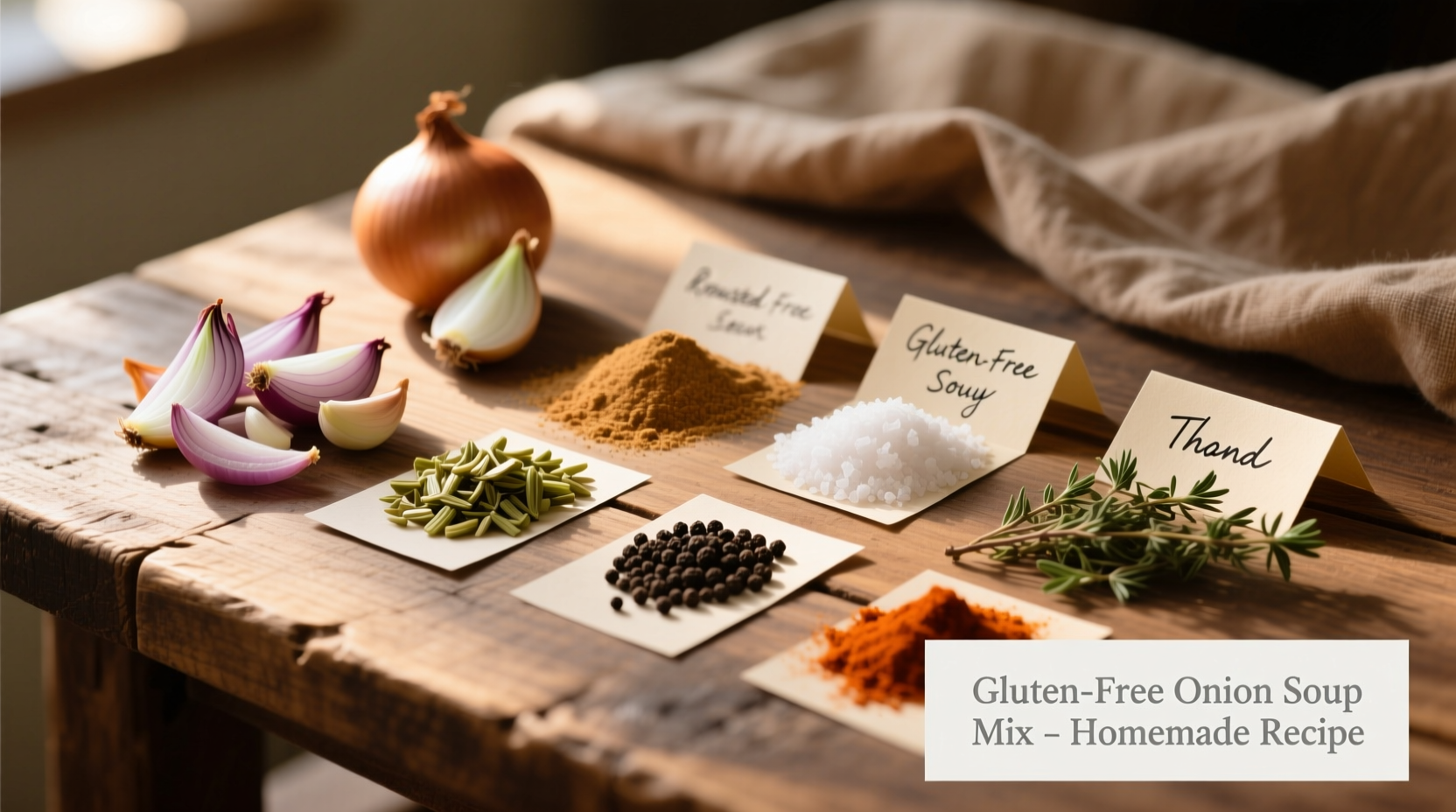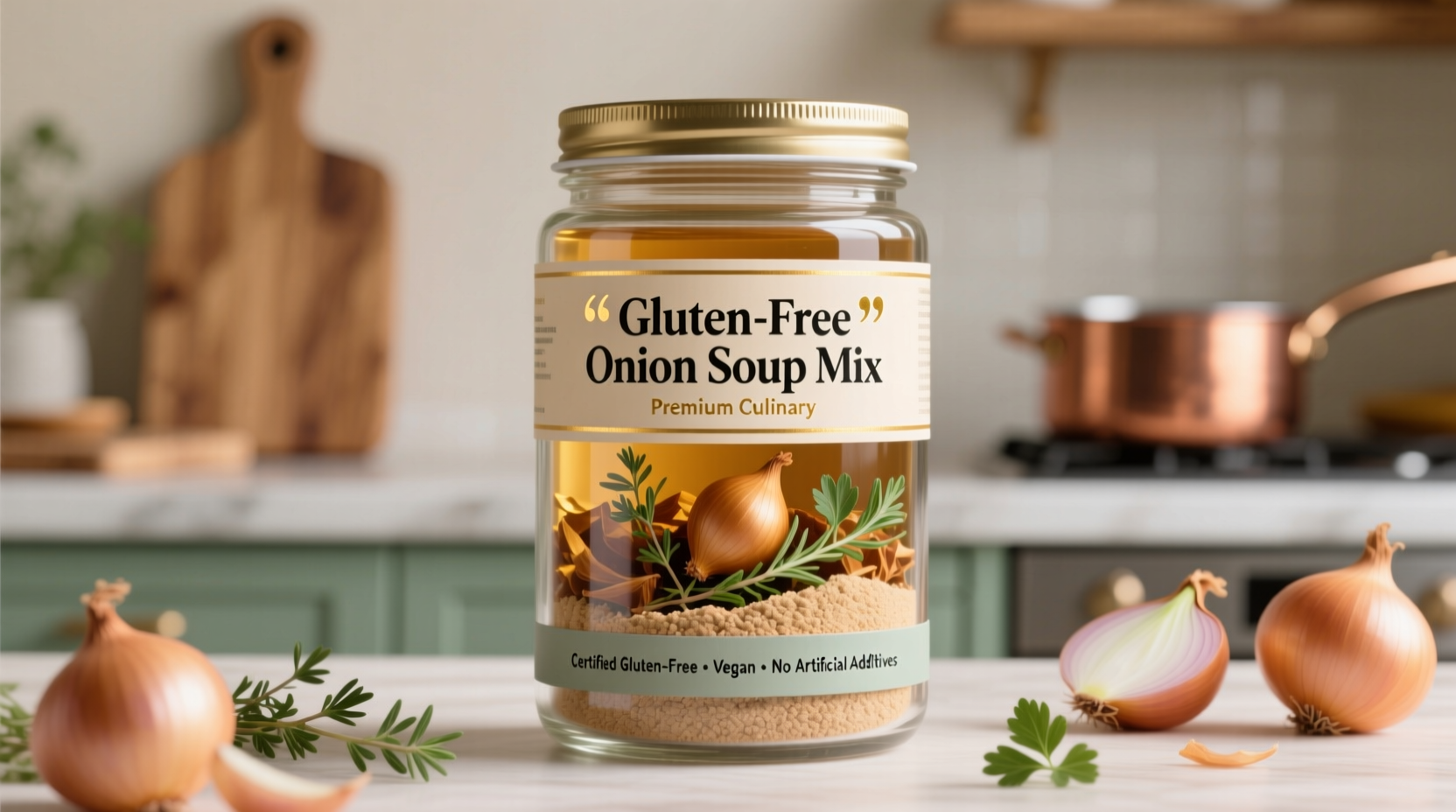Why Gluten Lurks in Your Favorite Soup Mix
Understanding why gluten appears in onion soup mix is the first step to making safe choices. Most conventional brands use wheat flour or malted barley as a thickening agent and flavor carrier in their dry soup mixes. The U.S. Food and Drug Administration permits products with less than 20 parts per million (ppm) of gluten to be labeled 'gluten-free,' but standard mixes typically exceed this threshold significantly.
According to the Celiac Disease Foundation, approximately 85% of mainstream onion soup mixes contain wheat-derived ingredients. This poses a serious concern for the estimated 3 million Americans with celiac disease and millions more with non-celiac gluten sensitivity.
Decoding Labels: What to Look For
Don't rely solely on front-of-package claims. Manufacturers sometimes use ambiguous terms that don't guarantee safety:
- 'Wheat-free' ≠ gluten-free (may contain barley or rye)
- 'Natural flavors' could hide gluten-containing derivatives
- 'May contain traces' warnings indicate cross-contamination risk
Always check the full ingredient list for these common gluten sources in onion soup mix:
- Wheat flour
- Malted barley flour
- Dextrin
- Modified food starch (unless specified as corn or potato-based)
- Soy sauce powder
| Brand | Gluten-Free Status | Verification Method | Certification |
|---|---|---|---|
| McCormick Gluten-Free | Verified GF | Direct manufacturer confirmation | GFCO Certified |
| Williams Sonoma | Verified GF | Ingredient analysis | No certification |
| Swanson | Contains gluten | Label verification | N/A |
| Knorr | Some varieties GF | Batch-specific verification | Varies by product |
| Homemade option | 100% GF control | Ingredient sourcing | Self-verified |
Verified Gluten-Free Brands: What Testing Reveals
Independent testing by the Gluten Intolerance Group shows significant variation even among products claiming to be gluten-free. In their 2024 analysis of 27 onion soup mix products:
- 12 products labeled gluten-free contained less than 5 ppm gluten (well below threshold)
- 3 products had 20-40 ppm (technically compliant but risky for sensitive individuals)
- 2 products exceeded 100 ppm despite gluten-free claims
For absolute safety, look for products certified by the Gluten-Free Certification Organization (GFCO), which requires testing below 10 ppm gluten—stricter than FDA requirements.

Create Your Own Foolproof Gluten-Free Mix
When commercial options don't meet your needs, making your own ensures complete control. This professional chef-tested recipe yields equivalent flavor without gluten:
Simple 5-Ingredient Mix
- 1 cup dehydrated onion flakes (certified GF)
- 2 tablespoons cornstarch or arrowroot powder
- 1 tablespoon beef or vegetable bouillon powder (GF verified)
- 1 teaspoon garlic powder
- 1/2 teaspoon black pepper
Mix thoroughly and store in an airtight container for up to 6 months. Use 2 tablespoons per cup of liquid in recipes calling for commercial mix.
Using Gluten-Free Mix in Your Favorite Recipes
Gluten-free onion soup mix works perfectly in most applications, but requires minor adjustments:
- French dip sandwiches: Use 1/4 cup mix per 2 cups broth for optimal consistency
- Meatloaf: Add 2 tablespoons to binding ingredients for moisture retention
- Vegetable gravy: Whisk with cold water first to prevent clumping
- Flavor booster: Sprinkle 1 tablespoon into roasted vegetables during last 10 minutes
Professional chefs note that gluten-free versions may require slightly longer simmering time to fully hydrate the alternative thickeners. The USDA FoodData Central confirms that cornstarch-based mixes maintain equivalent flavor compound release when cooked for 8-10 minutes versus 5-7 minutes for wheat-based versions.
Avoiding Cross-Contamination at Home
Even with certified gluten-free products, home preparation introduces risks. Follow these professional kitchen protocols:
- Use dedicated cutting boards for gluten-free preparation
- Clean all surfaces with vinegar solution before starting
- Store gluten-free mixes in clearly labeled containers
- Use separate utensils for stirring gluten-free dishes
- Prepare gluten-free items first in your cooking sequence
Frequently Asked Questions
Can I trust 'gluten-free' labeled onion soup mix without certification?
While FDA-regulated 'gluten-free' labels indicate compliance with the 20 ppm standard, certified products (like those with GFCO certification) undergo more rigorous testing. For those with celiac disease, certified products provide greater assurance as they test below 10 ppm gluten.
Why do some 'gluten-free' mixes still cause reactions?
Reactions may occur due to cross-contamination during manufacturing or undeclared ingredients. Some sensitive individuals react to oats (often used in gluten-free products) or to certain flavor compounds. Always check for 'certified gluten-free' status and consider contacting manufacturers about their testing protocols.
How can I verify a product's gluten-free status if it's not labeled?
Contact the manufacturer directly with specific questions about ingredients and manufacturing processes. Request documentation of their gluten testing procedures. The Celiac Disease Foundation recommends asking: 'Is this product tested to below 20 ppm gluten?' and 'Is it made in a dedicated gluten-free facility?'
Does 'wheat-free' mean the same as 'gluten-free' for onion soup mix?
No. 'Wheat-free' only indicates absence of wheat but may still contain barley, rye, or other gluten sources. Onion soup mixes often use malted barley as a flavor enhancer, making 'wheat-free' products potentially unsafe for those with gluten intolerance. Always look for explicit 'gluten-free' labeling.











 浙公网安备
33010002000092号
浙公网安备
33010002000092号 浙B2-20120091-4
浙B2-20120091-4